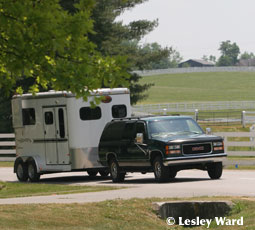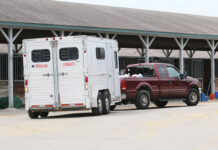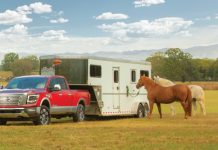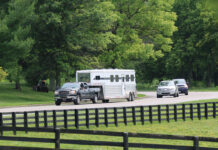 From the multitude of terms pertaining to ratings of horse trailers and tow vehicles, there are five that are extremely important to know and understand when determining towing capacities.
From the multitude of terms pertaining to ratings of horse trailers and tow vehicles, there are five that are extremely important to know and understand when determining towing capacities.
Gross Vehicle Weight Rating (GVWR) – the value specified by the manufacturer as the maximum loaded weight a single vehicle (truck or trailer) can safely hold.
Curb Weight – the empty weight of the trailer including standard equipment – not usually stated on the trailer. This is best determined by weighing the trailer after purchase.
Towing Capacity – the amount of weight the tow vehicle can safely pull as stated by the manufacturer.
Gross Combination Vehicle Weight Rating (GCVWR) – the stated maximum weight a tow vehicle and trailer can weigh combined, as set forth by the tow vehicle manufacturer.
With these terms, you can quickly determine if your entire rig is safe regarding weight loads and towing capacity. When putting a rig together, choose a trailer that will fit your current and future horses, then choose the tow vehicle that will safely pull it.
1) Determine the GVWR of the trailer. This can be found on a sticker somewhere on the trailer, or on the Certificate of Origin from the manufacturer. The GVWR is usually determined by axle capacity, tire capacity and coupler capacity. Note: This is important if you are changing tires or buying a used trailer – be sure the tire ratings will be equal or greater than the specified GVWR.
2) Now that you know the GVWR of the trailer, make sure you don’t overload it. For example, if you have a GVWR of 5000 pounds on a trailer that weighs 2400 pounds (Curb Weight), along with two 1300 pound horses, plus tack (GVW), you have exceeded the GVWR. A trailer with a GVWR of 7000 pounds would be necessary for these size horses.
3) Next, determine Towing Capacity. All motor vehicles used for towing will have a towing capacity listed in that manufacturer’s towing guide, model’s brochure, or on the manufacturer’s website. The guide will list the model with vehicle specs – the same models have different towing capacities depending on engine size, rear axle ratio and transmission. It may also list what the entire combined rig can weigh to include passengers, horses and equipment, and still be safe (GCVWR).
4) Once you know the GVWR of the trailer, search for a tow vehicle that can pull at least 10% more than the trailer’s GVWR. Check this against the GCVWR to make sure it’s not over.
5) Finally, don’t drastically overcompensate with the tow vehicle. It’s best to match the tow vehicle with trailer as stated above to give the horses the best possible ride.
Other helpful specs to look for in a tow vehicle:
For tag-along travelers, check the wheel base (the longer the wheel base, the more stable the tow vehicle) – no shorter than 120 inches, and use a weight distribution system hitch (often mistakenly called sway bars) to reduce front end floating.
For goosenecks, look at full size trucks and adequate wheel base.
Since you’re pulling live, shifting weight, we recommended that your tow vehicle weigh at least 4800 pounds (Curb Weight), preferably more, for a two horse tag-along trailer.
Tom Scheve and his wife Neva have three published books on horse trailers, including the nationally recognized textbook The Complete Guide to Buying, Maintaining, and Servicing a Horse Trailer. Tom and wife Neva have been advocating safety in horse trailer design since 1986 and are the developers of the EquiSpirit and EquiBreeze Line of Trailers, which are manufactured in Kinston, North Carolina. Tom is also an award winning writer of fiction novels – his recent published novel is The Awakening Of Surry County. They reside in Southern Pines, NC. For more info, contact Tom: 1-877-575-1771, tom@equispirit.com or visit them on-line at equispirit.com







It helps, saw it in Horse Illustrated, no-one else
has it. Curb weight figures needs easier answer
somewhere.
I would love to see a “Towing Capacity for Dummies” book or article where we could see a list of trucks/cars with their respective abilities for towing listed in plain English so all vehicles could be compared to each other at a glance.
I would like to get a horse they are pretty to me
I agree with Susan. Jeeps look able but are they? Also, if we’re looking at trucks how in the world are we going to weigh the trailer???
I think the article is a great starter piece on towing. I have towed horses for over 50 years, and usually pull a large Gooseneck with living quarters and slides. One thing you need to know and touch on is if you are pulling any kind of trailer with a vehicle and you are in an accident and the insurance company determines that your two vehicle was not capable of handling the trailer safely. They do not have to pay any claim if this is determined. I just took delivery on a custom trailer I ordered. It is 46 ft long, empty weight is 17,500 lbs, it has 3 axles which really takes a lot of weight off the tow vehicle. I ordered with disc brakes on all 3 axles with oil filled hubs. My 1 ton dually pulls the trailer just fine and it stops fantastic with the disc brake on the trailer, but in real life the truck is overloaded. I had talked with my insurance agent about the possibility of being in an accident with this setup. He recommended going to a series 7 truck which is a mid size truck just down in size from a full size semi truck which is a series 8 truck. Make a long story short I purchased a Freightliner Sport chassis truck with air brakes That is rated to two 36000 lbs. So now I know I have the correct truck to pull the trailer I own and my insurance company has me covered in case of an accident. I see so many large gooseneck trailer pulled by 1 ton dually and I know they can’t stop that trailer they are pulling if they have to make an emergency stop.